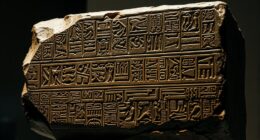Knotwork patterns use endless loops and interwoven lines to symbolize eternity, unity, and interconnectedness across different cultures. Whether Celtic, Asian, or Native American, these designs serve as visual reminders of life’s infinite cycle and shared human experience. Their continuous, unbroken lines represent how everything remains connected beyond time. If you keep exploring, you’ll discover the fascinating ways these patterns reflect universal themes and cultural stories of continuity and harmony.
Key Takeaways
- Endless loops in knotwork symbolize eternity, representing infinite time, interconnectedness, and the cyclical nature of life.
- Cultural variations, such as Celtic, Chinese, and Native American knots, convey shared themes of unity and spiritual continuity.
- The unbroken, continuous lines in knot patterns visually embody the concept of eternity and perpetual connection.
- Knotwork designs serve as visual metaphors for the interconnectedness of life, community, and spiritual beliefs across cultures.
- Their intricate, interlaced patterns act as symbols of harmony, unity, and the eternal cycle of existence.

Knotwork patterns are intricate designs that have captivated cultures around the world for centuries. You might notice how these patterns, often characterized by endless loops and interwoven lines, carry deep meanings that go beyond their visual complexity. They serve as a visual language, conveying concepts like eternity, unity, and interconnectedness through their intertwined symbolism. When you examine these designs, you’ll see that each knot tells a story—whether it’s about life’s cyclical nature or the bonds that hold communities together. Their symbolism isn’t just decorative; it’s a reflection of universal ideas that resonate across different times and places.
Knotwork patterns reveal universal stories of eternity, unity, and interconnectedness through intricate, symbolic designs.
As you explore various cultures, you’ll find that knotwork patterns take on distinct forms and significance, highlighting their cultural variations. For example, in Celtic art, knots often symbolize eternity and the interconnectedness of life and spirit. The endless loops in Celtic knots emphasize the idea that life, death, and rebirth are interconnected, a concept deeply rooted in their spiritual beliefs. Conversely, in Chinese art, knot designs such as the Chinese knots—known as “pan chang knots”—are used to symbolize good luck, longevity, and prosperity. These knots often feature symmetrical, geometric patterns that are believed to attract positive energy. Meanwhile, in Native American cultures, knotwork can be seen in beadwork and textiles, where the patterns often symbolize harmony and the interconnectedness of all living things, reflecting their spiritual worldview. Additionally, the use of leverage in traditional craft-making techniques demonstrates how complex patterns are created through skillful interlacing, echoing the importance of interconnectedness.
You might also notice that the way these knots are created varies depending on cultural context, but the fundamental idea remains the same: an unbroken, continuous line represents eternity. Whether it’s the complex interlacing of Celtic knots or the simplified geometric patterns found in Asian traditions, the core symbolism stays consistent. This shared concept of endlessness underscores a universal understanding—nothing truly ends, and everything remains connected in an infinite cycle. The intertwining symbolism in these patterns serves as a reminder of the enduring nature of life, relationships, and spiritual beliefs, making them more than mere decoration. They act as visual anchors, connecting generations and conveying values that transcend language.
Ultimately, knotwork patterns are a testament to human creativity and the universal desire to understand eternity and interconnectedness. Their cultural variations showcase how different societies interpret these ideas through unique artistic expressions, yet all share the common thread of emphasizing continuity and unity. When you appreciate these intricate designs, you’re not just admiring their beauty—you’re exploring a visual language that speaks to fundamental human truths shared across cultures and eras.
Frequently Asked Questions
What Cultural Origins Are Most Associated With Knotwork Patterns?
You might notice knotwork patterns often symbolize eternity or interconnectedness. These designs have strong roots in Celtic symbolism, where they represent endless cycles and spiritual unity. You’ll also find similar patterns in Chinese decorative arts, reflecting harmony and longevity. Both cultures use intricate, looping designs to convey profound meanings, making knotwork a universal symbol of eternity, unity, and cultural identity across different traditions.
How Are Knotwork Patterns Used in Modern Design and Fashion?
You can see knotwork patterns in modern design and fashion, making a statement in interior decorating and contemporary jewelry. These intricate patterns add a timeless, symbolic touch to furniture, wall art, and accessories. You might wear knot-inspired jewelry or incorporate them into home decor for a unique, meaningful look. Their endless loops symbolize eternity, which resonates well with current trends emphasizing connection and continuity.
Do Knotwork Patterns Have Specific Symbolic Meanings Across Different Cultures?
You might find it fascinating that knotwork patterns carry specific symbolic meanings across cultures. These designs often symbolize eternity, unity, or interconnectedness, reflecting their cultural significance. For example, Celtic knots represent endless life, while Chinese knots symbolize good luck. The coincidence is that despite cultural differences, these patterns share a common theme of continuity and harmony, making them powerful symbols with diverse yet connected symbolic meanings worldwide.
What Materials Are Traditionally Used to Create Knotwork Art?
You’ll find that traditional knotwork art often uses materials like leather, wood, metal, and parchment, showcasing skilled material craftsmanship. These materials are chosen for their durability and cultural significance. Bright colors and intricate patterns often carry color symbolism, representing things like life, spirituality, or protection. When creating knotwork, you blend these materials and symbolism to craft meaningful designs that reflect cultural values and artistic traditions.
How Can Beginners Learn to Draw or Create Knotwork Patterns?
To learn knotwork patterns, start by practicing basic techniques like drawing continuous lines and focusing on pattern symmetry. Use grid paper to keep your loops even and develop your skills gradually. Study existing designs to understand their flow, and replicate them to build confidence. Consistent practice helps you recognize how to create seamless, endless loops, making your knotwork more intricate and balanced over time.
Conclusion
You can see knotwork patterns as more than just decorative designs—they symbolize eternity and interconnectedness. Imagine a community weaving a large knotwork mural, each person adding their own loop, representing unity and continuity. Just like that mural, these endless loops remind you that life’s connections are infinite and unbreakable. Next time you spot a knotwork design, think about how it reflects your own journey—intertwined, endless, and full of meaning.











